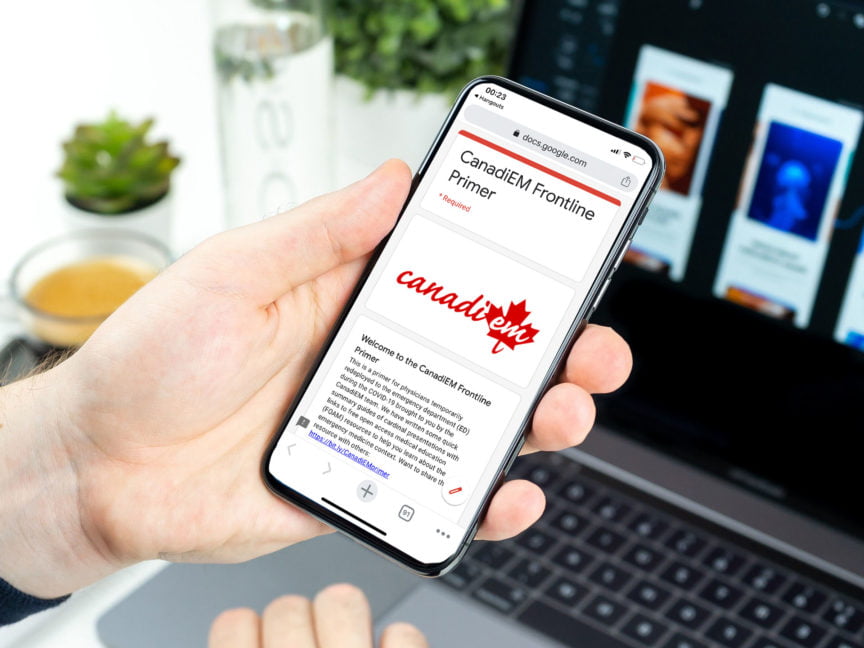Points to Focus upon
- Consulting others in the outpatient or non-emergency setting may be quite different than the procedures we might use in the emergency department1. The following mnemonics can help you to scaffold your consultation requests so that you can quickly communicate with your consulting colleagues.
- As someone who has been redeployed in the ED, you’re already starting at a bit of a disadvantage. Previous literature has shown that familiarity is a key facet to successful consultations2 and a prior track record may be helpful in decreasing conflict around consultations3.
- Previous literature notes that the interpersonal communications around consultations can be wrought with conflict, but this can be mitigated by establishing trust and using clear communication.
PIQUED Mnemonic4
- P – Prepare – Review and know your stuff
- I – Identify – Make sure you identify yourself, your redeployment status, the consultant, the patient
- Q – Question – Make your clinical question very clear while consulting (e.g. Will you come admit this patient?)
- U – Urgency – How sick is the patient? Do they have COVID-19?
- E – Educational modifications – Learn something while you’re on the call if you can
- D – Debrief – Connect with colleague later to see how patient did, or when they come down to ED
5C’s Model5,6
- C – Contact – Introduce yourself, invite consultant to do same.
- C – Communicate – Give a concise story (Start with the headline: Reason For Referral)
- C – Core question – Ask a specific question or request!
- C – Collaborate – Discuss things that might help the consultant with their next steps
- C – Close the loop – Confirm the plan, update if changes happen
Consulting7
- C – Contact courteously – BE NICE TO YOUR CONSULTANTS*
- O – Orient – Tell them where you need them, and who you’d like them to see!
- N – Narrow question – Clarify your query. Are you asking them to do something? To provide an opinion?
- S – Story – Provide a succinct HPI and emergency department course summary
- U – Urgency – How sick is the patient? How quickly should they come?
- L – Later – Explain how they can close the loop with you
- T – Thank-you – Be nice, again!
- *…but make sure you have the right person and know their status.
Recommended Reading, Videos, and Podcasts
- ALiEM Card – Consultations from the Emergency Department
- Annals of Emergency Medicine – Conquering Consultations: A Guide to Advances in the Science of Referral-Consultation Interactions for Residency Education
Related topic – CanadiEM Frontline Primer ED Skills – Safe Handover
The following is part of the CanadiEM Frontline Primer. An introduction to the primer can be found here. To return to the Primer content overview click here.
This post was copyedited and uploaded by Johnny Huang.
References
- 1.Baylis J, Miloslavsky E, Woods R, Chan T. Conquering Consultations: A Guide to Advances in the Science of Referral-Consultation Interactions for Residency Education. Ann Emerg Med. 2019;74(1):119-125. doi:10.1016/j.annemergmed.2018.12.004
- 2.Chan T, Sabir K, Sanhan S, Sherbino J. Understanding the impact of residents’ interpersonal relationships during emergency department referrals and consultations. J Grad Med Educ. 2013;5(4):576-581. doi:10.4300/JGME-D-12-00211.1
- 3.Chan T, Bakewell F, Orlich D, Sherbino J. Conflict prevention, conflict mitigation, and manifestations of conflict during emergency department consultations. Acad Emerg Med. 2014;21(3):308-313. doi:10.1111/acem.12325
- 4.Chan T, Orlich D, Kulasegaram K, Sherbino J. Understanding communication between emergency and consulting physicians: a qualitative study that describes and defines the essential elements of the emergency department consultation-referral process for the junior learner. CJEM. 2013;15(1):42-51. doi:10.2310/8000.2012.120762
- 5.Kessler C, Afshar Y, Sardar G, Yudkowsky R, Ankel F, Schwartz A. A prospective, randomized, controlled study demonstrating a novel, effective model of transfer of care between physicians: the 5 Cs of consultation. Acad Emerg Med. 2012;19(8):968-974. doi:10.1111/j.1553-2712.2012.01412.x
- 6.Kessler C, Kalapurayil P, Yudkowsky R, Schwartz A. Validity evidence for a new checklist evaluating consultations, the 5Cs model. Acad Med. 2012;87(10):1408-1412. doi:10.1097/ACM.0b013e3182677944
- 7.Podolsky A, Stern D, Peccoralo L. The Courteous Consult: A CONSULT Card and Training to Improve Resident Consults. J Grad Med Educ. 2015;7(1):113-117. doi:10.4300/JGME-D-14-00207.1


